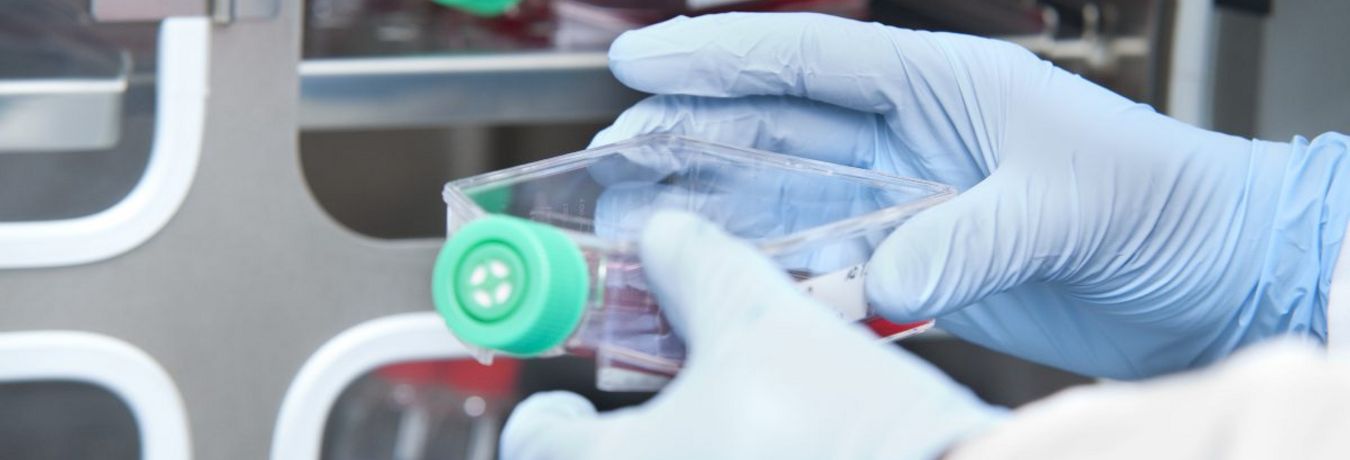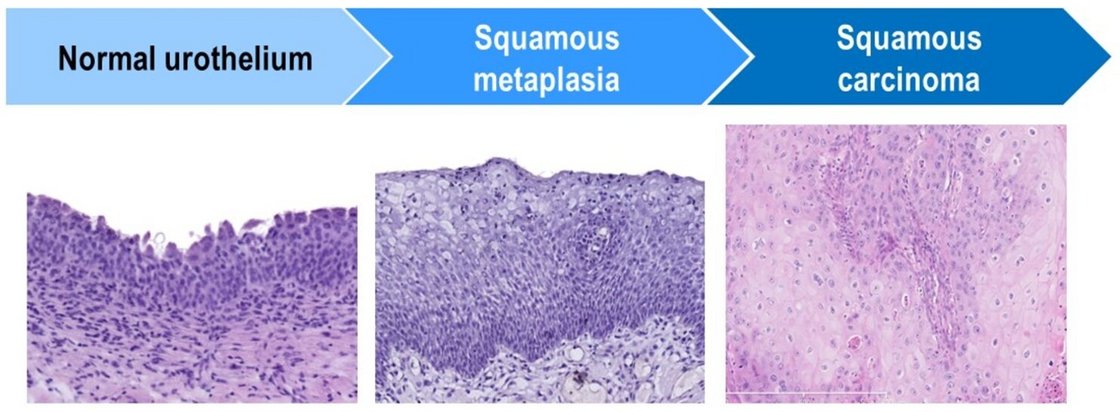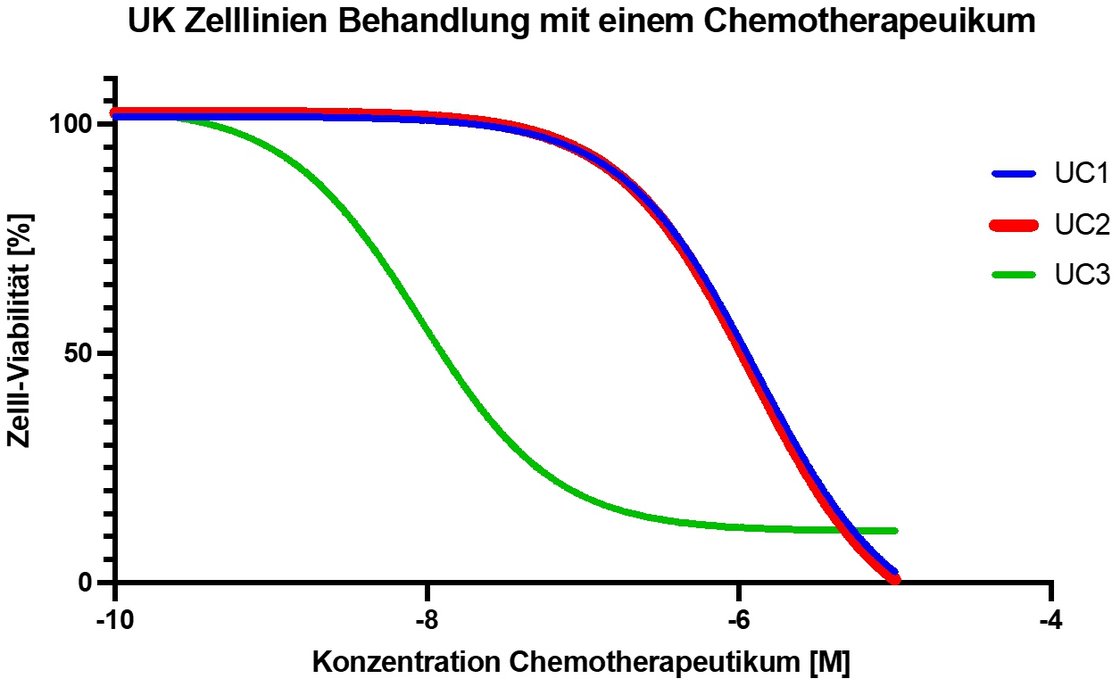The scientific objective of our research group is to better understand how bladder cancer in particular starts, grows and develops and how we can optimise treatment.
Urinary bladder cancer is the sixth most common cancer in men and the 17th most common in women worldwide, with different types and histologies and a very diverse disease course [1]. While papillary non-invasive carcinomas have 5-year survival rates of up to 95 %, more than 50 % of patients with metastases die within one year (5-year survival rate 5 %) [2,3].
Our research activities are therefore based on understanding the basic organisation and differentiation of the epithelium of the urinary bladder (urothelium) in the normal state and in benign changes as well as malignant tumour diseases. The subsequent central aim of our work is to decipher the molecular landscapes and clonal growth patterns during the development and progression of urothelial and squamous cell carcinomas of the urinary bladder. This will improve the subtyping of tumours and help to identify and select effective (targeted and likely personalised) treatment options.
Main research areas
Squamous differentiation
Pure squamous cell carcinoma (SCC) of the urinary bladder is a rarely diagnosed disease that is associated with an unfavourable prognosis and fewer options for promising (neo)adjuvant therapy. Keratinising squamous metaplasia with dysplasia is considered a possible, but not always present, precursor lesion [4]. However, squamous epithelial redifferentiation of the urothelium also occurs as a result of inflammatory stimuli and are often stable lesions without a tendency to degenerate [4]. However, the molecular mechanisms that enable such abnormal differentiation of urothelial cells into squamous epithelial cells, sometimes leading to highly aggressive cancers, are poorly understood. Therefore, we are interested in the development of squamous cell carcinomas of the urinary bladder with a particular focus on putative (early) key factors that may hold promise for novel therapeutic implications.
Clonal evolution of bladder carcinoma
There are different pathways in the tumourigenesis of the urinary bladder, which also differ morphologically and prognostically (see above). However, we have already dealt in the past with how tumour heterogeneity and clonal growth occur within a carcinoma and what significance they have clinically [5]. The (epi)genetic landscapes of urothelial clonal expansion from carcinoma in situ (CIS) to muscle-invasive carcinoma (MIBC) are also interesting - and little researched. We are interested in intra- and interpatient-specific DNA methylation patterns (DNAme) and their effects on transcriptional networks that may be causative for the progression of CIS-(un)dependent clonal expansion. This project is part of a research group funded by the German Research Foundation (DFG)(https://gepris.dfg.de/gepris/projekt/493802833?context=projekt&task=showDetail&id=493802833&).
Therapeutic approaches for bladder cancer
In the age of personalised medicine, we also test targeted, novel therapeutics such as EGFR (Epidermal Growth Factor Receptor), FGFRs (Fibroblast Growth Factor Receptors), immune checkpoint inhibitors (PD-L1) or S-methyl-5'-thioadenosine phosphorylase (MTAP) for effectiveness in cell culture in our laboratory, depending on the genetic background of the tumours. Therapy response and resistance development as well as the underlying molecular mechanisms are the focus of our work.
Our research group uses a wide range of instruments based on tissues, cell cultures, classical molecular biology, next generation sequencing (NGS) and bioinformatics, which enable us to comprehensively analyse pathological changes. We are constantly expanding our "toolbox" with new in-vitro and ex-vivo methods.
We are open to collaborative projects in the field of bladder cancer (or gastrointestinal tumour diseases) and are in active exchange with researchers within the Medical Faculty of Ulm University and Ulm University Hospital, but also outside Ulm and Germany.
Team
Prof. Dr med. Dr nat. med. Nadine Gaisa
PD Dr rer. nat. Michael Rose
Dr rer. nat. Emil Chteinberg
Dr rer. nat. Francesca Spada
Melika Rezaei, M. Sc.
Elisa Lemaitre, physician
Researcher:
Anastasiia Kyrychenko
References
[1] Jubber I, Ong S, Bukavina L, Black PC, Compérat E, Kamat AM, Kiemeney L, Lawrentschuk N, Lerner SP, Meeks JJ, Moch H, Necchi A, Panebianco V, Sridhar SS, Znaor A, Catto JWF, Cumberbatch MG. Epidemiology of Bladder Cancer in 2023: A Systematic Review of Risk Factors. Eur Urol. 2023 Aug;84(2):176-190. doi: 10.1016/j.eururo.2023.03.029
[2] Oliver-Krasinski JM, Bidot S, Ingram JW, O'Toole KM, McKiernan JM, Tinsley M, Harik LR. Noninvasive Papillary Urothelial Carcinoma of the Bladder: An Institutional Experience Focusing on Tumours With Borderline Features. Arch Pathol Lab Med. 2024 Feb 1;148(2):223-229. doi: 10.5858/arpa.2022-0268-OA.
[3] Soares A, Bourlon MT, Wong A, Joshi A, Jardim D, Korbenfeld E, Karak FE, Orlandi F, Sze H, Ansari J, Zarba J, Mansour MA, Manneh R, Thirumulai R, Tsai YC, Morsi WA, Powles T. Management of Metastatic Urothelial Carcinoma in Emerging Markets (EM): An Expert Opinion. Clin Genitourin Cancer. 2024 Apr;22(2):467-475. doi: 10.1016/j.clgc.2024.01.001
[4] Martin JW, Carballido EM, Ahmed A, Farhan B, Dutta R, Smith C, Youssef RF. Squamous cell carcinoma of the urinary bladder: Systematic review of clinical characteristics and therapeutic approaches. Arab J Urol. 2016 Aug 1;14(3):183-91. doi: 10.1016/j.aju.2016.07.001
[5] Heide T, Maurer A, Eipel M, Knoll K, Geelvink M, Veeck J, Knuechel R, van Essen J, Stoehr R, Hartmann A, Altmueller J, Graham TA, Gaisa NT. Multiregion human bladder cancer sequencing reveals tumour evolution, bladder cancer phenotypes and implications for targeted therapy. J Pathol. 2019 Jun;248(2):230-242. doi: 10.1002/path.5250.
Pannhausen J, Wirtz J, Mantwill K, Holm PS, Schwamborn K, Jonigk DD, Gschwend JE, Rose M, Gaisa NT, Nawroth R. Oncolytic virotherapy provides a potent therapy option for squamous bladder cancer. Sci Rep. 2025 Apr 18;15(1):13443. doi: 10.1038/s41598-025-96419-3. PMID: 40251219; PMCID: PMC12008219.
Melzer MK, Ma Y, Lindenmayer J, Morgenstern C, Wezel F, Zengerling F, Günes C, Gaisa NT, Kleger A, Bolenz C. Prospective pharmacotyping of urothelial carcinoma organoids for drug sensitivity prediction - feasibility and real world experience. Exp Hematol Oncol. 2024 Nov 12;13(1):112. doi: 10.1186/s40164-024-00579-3. PMID: 39533373; PMCID: PMC11558855.
Lammert FC, Pannhausen J, Noetzel E, Friedland F, Wirtz J, Herfs Y, Leypold S, Gan L, Weiskirchen R, Schnitzler T, Knüchel R, Maurer J, Jonigk DD, Rose M, Gaisa NT. Dual role of GRHL3 in bladder carcinogenesis depending on histological subtypes. Mol Oncol. 2024 Jun;18(6):1397-1416. doi: 10.1002/1878-0261.13623. Epub 2024 Mar 2. PMID: 38429970; PMCID: PMC11164254.



